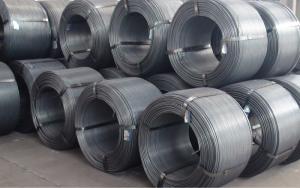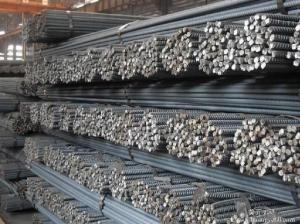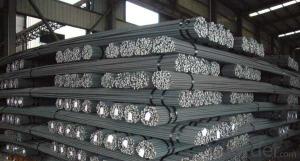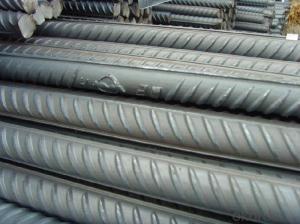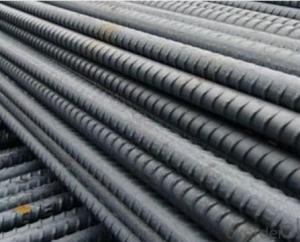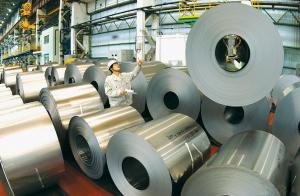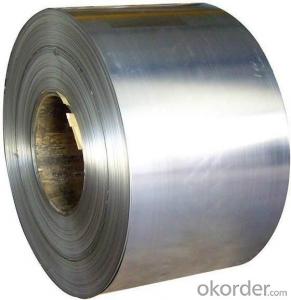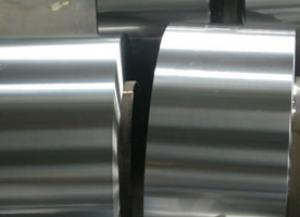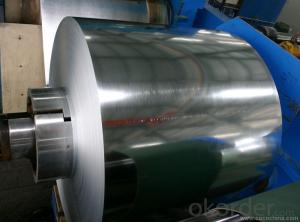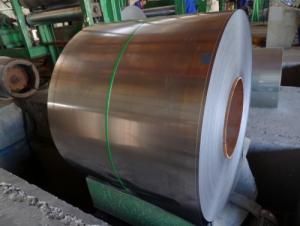Cold Rolled Rebar Coil CRB550
- Loading Port:
- China Main Port
- Payment Terms:
- TT OR LC
- Min Order Qty:
- -
- Supply Capability:
- -
OKorder Service Pledge
OKorder Financial Service
You Might Also Like
Grade | Size | Wire | Standard |
CRB550 | Diameter:5.5-12mm | Size:5.5-12mm | GB13788-2008 |
Length:2m-9m |
Packaging & Delivery of Hot Rolled Steel Rebar:
Packaging Detail: products are packed in bundle and then shipped by container or bulk vessel, deformed bar is usually naked strapping delivery, when storing, please pay attention to moisture proof. The performance of rust will produce adverse effect.
Each bundle weight: 2-3MT, or as required
Payment terms: TT payment in advance or Irrevocable LC at sight.
Trade terms :FOB, CFR, CIF
Label:to be specified by customer, generally, each bundle has 1-2 labels
Steel Rebar in stock
- Q: How are steel rebars handled and stored on construction sites?
- Construction projects that require reinforced concrete structures rely on steel rebars, which are also known as reinforcing bars. Ensuring the quality and safety of these rebars when handling and storing them on construction sites is of utmost importance. Upon delivery to the construction site, the steel rebars must undergo inspection for any signs of damage or corrosion. If any rebars are found to be damaged, they should be discarded as they can compromise the project's structural integrity. Additionally, the rebars should be checked for proper labeling, including grade, size, and other specifications. Mechanical lifting equipment, such as cranes or forklifts, is typically used to handle steel rebars. It is crucial to use appropriate lifting tools to prevent mishandling or accidents that could result in injuries. The rebars should be lifted vertically to avoid bending or distortion. Once lifted, the steel rebars should be stored in a designated area called a rebar yard. This yard should be clean, well-drained, and organized to prevent potential damage or corrosion. The rebars should be stacked horizontally on leveled ground, ensuring they do not come into direct contact with the soil or water to avoid rusting. To prevent the rebars from rolling or falling, they should be securely tied together using binding wires or steel bands. This practice not only helps maintain the order and stability of the stored rebars but also prevents accidental damage by keeping them away from other construction materials, machinery, or equipment. Proper storage also involves protecting the rebars from adverse weather conditions. Waterproof tarpaulins or plastic sheets should be used to cover the rebars, preventing moisture absorption and corrosion. Adequate ventilation is necessary to avoid moisture accumulation, which can lead to rusting. Regular inspections of the stored rebars are crucial to identify any signs of damage or deterioration. If any rebars are found to be damaged or rusty, they should be promptly removed and replaced to preserve the structural integrity of the construction project. In conclusion, the handling and storage of steel rebars on construction sites require careful attention. Suitable lifting equipment should be used during handling, and a clean and organized rebar yard is necessary for storage. Regular inspections and maintenance are essential to ensure the rebars' quality and prevent any compromise to the construction project's structural integrity.
- Q: What are the factors considered in designing with steel rebars?
- To ensure the structural integrity and safety of the final structure, various factors are taken into consideration when designing with steel rebars. These factors encompass the following: 1. The structural requirements of the project are the foremost consideration. This involves determining the load capacity, the type of structure, and the desired strength and durability. 2. Designers must adhere to building codes and regulations established by local authorities. These codes specify the minimum standards for materials, design, and construction to ensure the structure meets safety and performance requirements. 3. Steel rebars come in different grades and sizes, each possessing unique mechanical properties. Hence, the designer must choose the appropriate grade and size of rebars based on the structural requirements and specifications. 4. Proper placement and spacing of steel rebars are essential in providing sufficient reinforcement. This entails determining the number of rebars, their diameter, and the spacing between them to ensure even distribution of forces and prevent structural failure. 5. Steel rebars must be adequately covered by concrete to safeguard against corrosion. The designer must determine the necessary concrete cover based on environmental conditions, exposure to moisture or chemicals, and the desired service life of the structure. 6. Corrosion protection is a vital consideration since steel rebars are prone to corrosion, which can weaken the structure over time. Designers must evaluate methods of corrosion protection, such as utilizing epoxy-coated rebars, increasing concrete cover, or implementing cathodic protection systems. 7. The design should also take into account the construction process and the ease of installation. This involves considering the accessibility of rebars, the feasibility of construction techniques, and any special requirements for placement and anchorage. By considering these factors, designers can develop steel rebar designs that adhere to safety standards, offer adequate reinforcement, and ensure the durability of the structure.
- Q: How do steel rebars contribute to the overall seismic performance of a structure?
- Steel rebars contribute to the overall seismic performance of a structure by providing reinforcement and strength. The rebars are embedded in concrete, creating a composite material that enhances the structural integrity and resistance to seismic forces. They help to distribute the applied loads more evenly, absorb and dissipate energy during earthquakes, and prevent the concrete from cracking or failing under stress. Overall, steel rebars significantly improve the resilience and safety of structures in seismic events.
- Q: What is the role of steel rebars in industrial flooring construction?
- Steel rebars play a crucial role in industrial flooring construction as they provide reinforcement and strength to the concrete. By being embedded within the concrete slab, rebars help to distribute loads evenly, resist tension forces, and prevent cracking or structural failure. They enhance the durability and longevity of the flooring, making it capable of withstanding heavy loads, impact, and vibrations commonly encountered in industrial settings.
- Q: How do steel rebars contribute to the ductility of reinforced concrete structures?
- Steel rebars contribute to the ductility of reinforced concrete structures by providing reinforcement and increasing tensile strength. The rebars act as a skeleton within the concrete, absorbing and distributing external forces such as tension and compression. This reinforcement prevents the concrete from cracking or failing under stress, allowing the structure to withstand greater loads and deform without collapsing, thus enhancing its overall ductility.
- Q: How do steel rebars affect the overall sustainability of a construction project?
- Steel rebars can positively impact the overall sustainability of a construction project in several ways. Firstly, steel rebars enhance the structural integrity of concrete structures, increasing their longevity and reducing the need for maintenance or replacement over time. This reduces the overall environmental impact of the project by minimizing material waste and resource consumption. Additionally, steel rebars can be recycled at the end of their lifecycle, reducing the demand for virgin steel production and lowering carbon emissions associated with manufacturing. Moreover, the strength and durability of steel rebars allow for the construction of more resilient buildings, which can withstand natural disasters and minimize the need for reconstruction, thus promoting long-term sustainability in terms of both environmental and economic aspects.
- Q: What is the effect of steel rebars on the weight of a structure?
- Steel rebars have a significant effect on the weight of a structure. Rebars are typically made of steel, which is known for its high strength-to-weight ratio. When incorporated into a structure, these reinforcement bars add strength and rigidity without significantly increasing the overall weight. By reinforcing concrete with steel rebars, the structure becomes better equipped to withstand various forces and stresses, such as tension, compression, bending, and shearing. This reinforcement allows the structure to handle heavier loads and increases its overall durability and longevity. While steel rebars add strength to the structure, they do not significantly contribute to its weight. This is beneficial as it allows for the construction of lighter and more efficient structures. The reduced weight can have several advantages, including lower construction costs, reduced material requirements, decreased transportation costs, and improved seismic performance. Moreover, the use of steel rebars also enables the construction of more slender and aesthetically pleasing structures. The increased strength provided by the rebars allows for the use of thinner concrete sections, resulting in sleek designs and more open spaces. In summary, the effect of steel rebars on the weight of a structure is minimal. Instead, their primary role is to enhance the structural integrity, strength, and durability of the building without adding excessive weight.
- Q: Can steel rebars be used in wastewater storage tanks?
- Yes, steel rebars can be used in wastewater storage tanks. Steel rebars are commonly used as reinforcement in concrete structures, including wastewater storage tanks. The rebars provide tensile strength to the concrete, making it more resistant to cracking and improving the overall structural integrity of the tank. Additionally, steel rebars are corrosion-resistant, which is crucial in wastewater storage tanks where exposure to corrosive elements is inevitable. Therefore, using steel rebars in wastewater storage tanks is a common and effective practice in the construction industry.
- Q: What are the guidelines for spacing steel rebars in reinforced concrete?
- Spacing steel rebars in reinforced concrete structures can vary depending on factors such as structural design requirements, load-bearing capacity, and the size and shape of concrete elements. However, there are some general guidelines that can be followed to ensure proper spacing and reinforcement. 1. Rebar spacing: The recommended spacing between steel rebars in reinforced concrete is typically three to six times the diameter of the bars. For example, if the rebar diameter is 12mm, the spacing should be between 36mm and 72mm. This spacing allows for adequate concrete cover and allows the concrete to flow freely around the reinforcement, ensuring optimal strength and durability. 2. Minimum spacing: To prevent rebars from being too close to each other, minimum spacing requirements are in place. This is to avoid inadequate concrete cover and hindered flow of concrete during construction. The minimum spacing between parallel bars is generally specified to be around 25mm or more. 3. Maximum spacing: On the other hand, there are also maximum spacing requirements to ensure sufficient reinforcement and prevent excessive cracking or failure of the concrete structure. The typical maximum spacing is around 300mm, although this may vary based on specific design requirements and the size of the concrete element being reinforced. 4. Spacing around corners and bends: Special attention should be given to rebars' spacing around corners and bends in reinforced concrete elements. The spacing should be reduced in these areas to provide adequate reinforcement and prevent cracks or weak points. In general, the spacing around corners and bends should be less than the recommended spacing for straight sections. 5. Spacing in heavily loaded areas: In areas subjected to heavy loads or high-stress concentrations, such as columns, beams, or foundations, closer spacing of rebars is necessary to provide sufficient reinforcement. The spacing in these areas is typically reduced to ensure structural integrity and prevent failure. It is important to note that these guidelines are general recommendations, and specific projects may have unique requirements based on structural design and local building codes. Therefore, consulting with a structural engineer or following the specifications provided by the project's design professionals is crucial to ensure the proper spacing of steel rebars in reinforced concrete structures.
- Q: How are steel rebars checked for proper alignment during construction?
- Steel rebars are checked for proper alignment during construction using various methods. One common approach is to visually inspect the rebars to ensure they are positioned correctly according to the construction plans and specifications. Additionally, laser alignment tools or string lines may be used to ensure the rebars are placed in a straight line and at the correct depth. Construction professionals may also use measuring devices, such as calipers or tape measures, to verify the rebars' spacing and alignment. Regular quality control checks and inspections are crucial to ensure the rebars are aligned correctly, as this is essential for the structural integrity of the construction project.
Send your message to us
Cold Rolled Rebar Coil CRB550
- Loading Port:
- China Main Port
- Payment Terms:
- TT OR LC
- Min Order Qty:
- -
- Supply Capability:
- -
OKorder Service Pledge
OKorder Financial Service
Similar products
Hot products
Hot Searches
Related keywords
